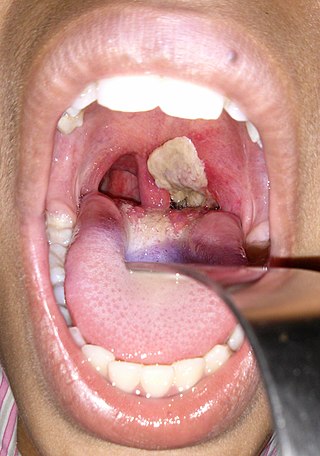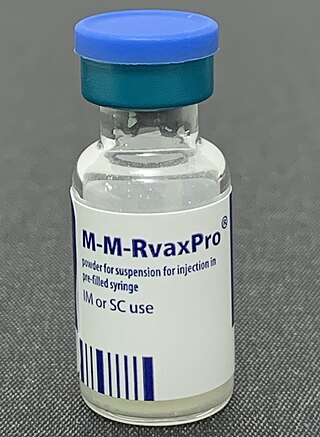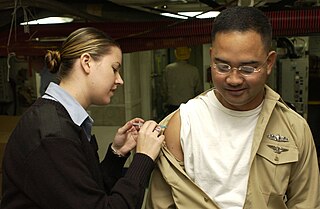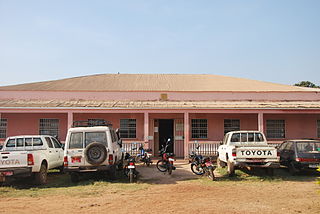
The Bacillus Calmette–Guérin (BCG) vaccine is a vaccine primarily used against tuberculosis (TB). It is named after its inventors Albert Calmette and Camille Guérin. In countries where tuberculosis or leprosy is common, one dose is recommended in healthy babies as soon after birth as possible. In areas where tuberculosis is not common, only children at high risk are typically immunized, while suspected cases of tuberculosis are individually tested for and treated. Adults who do not have tuberculosis and have not been previously immunized, but are frequently exposed, may be immunized, as well. BCG also has some effectiveness against Buruli ulcer infection and other nontuberculous mycobacterial infections. Additionally, it is sometimes used as part of the treatment of bladder cancer.

Diphtheria is an infection caused by the bacterium Corynebacterium diphtheriae. Most infections are asymptomatic or have a mild clinical course, but in some outbreaks, the mortality rate approaches 10%. Signs and symptoms may vary from mild to severe, and usually start two to five days after exposure. Symptoms often develop gradually, beginning with a sore throat and fever. In severe cases, a grey or white patch develops in the throat, which can block the airway, and create a barking cough similar to what is observed in croup. The neck may also swell, in part due to the enlargement of the facial lymph nodes. Diphtheria can also involve the skin, eyes, or genitals, and can cause complications, including myocarditis, inflammation of nerves, kidney problems, and bleeding problems due to low levels of platelets.

The MMR vaccine is a vaccine against measles, mumps, and rubella, abbreviated as MMR. The first dose is generally given to children around 9 months to 15 months of age, with a second dose at 15 months to 6 years of age, with at least four weeks between the doses. After two doses, 97% of people are protected against measles, 88% against mumps, and at least 97% against rubella. The vaccine is also recommended for those who do not have evidence of immunity, those with well-controlled HIV/AIDS, and within 72 hours of exposure to measles among those who are incompletely immunized. It is given by injection.

Influenza vaccines, colloquially known as flu shots or the flu jab, are vaccines that protect against infection by influenza viruses. New versions of the vaccines are developed twice a year, as the influenza virus rapidly changes. While their effectiveness varies from year to year, most provide modest to high protection against influenza. Vaccination against influenza began in the 1930s, with large-scale availability in the United States beginning in 1945.

Meningococcal disease describes infections caused by the bacterium Neisseria meningitidis. It has a high mortality rate if untreated but is vaccine-preventable. While best known as a cause of meningitis, it can also result in sepsis, which is an even more damaging and dangerous condition. Meningitis and meningococcemia are major causes of illness, death, and disability in both developed and under-developed countries.
The National Public Health Institute of Finland was a research and expert institute under the Ministry of Social Affairs and Health charged with the task of protecting and promoting health in Finland. KTL was founded in 1911; the final form was established in 1982 in order to promote public health in Finland.

Pneumococcal vaccines are vaccines against the bacterium Streptococcus pneumoniae. Their use can prevent some cases of pneumonia, meningitis, and sepsis. There are two types of pneumococcal vaccines: conjugate vaccines and polysaccharide vaccines. They are given by injection either into a muscle or just under the skin.

The Bandim Health Project works with population based health research in one of the world's poorest countries, Guinea-Bissau in West Africa.

The Haemophilus influenzae type B vaccine, also known as Hib vaccine, is a vaccine used to prevent Haemophilus influenzae type b (Hib) infection. In countries that include it as a routine vaccine, rates of severe Hib infections have decreased more than 90%. It has therefore resulted in a decrease in the rate of meningitis, pneumonia, and epiglottitis.
The rotavirus vaccine is a vaccine used to protect against rotavirus infections, which are the leading cause of severe diarrhea among young children. The vaccines prevent 15–34% of severe diarrhea in the developing world and 37–96% of the risk of death among young children due to severe diarrhea. Immunizing babies decreases rates of disease among older people and those who have not been immunized.
NmVac4-A/C/Y/W-135 is the commercial name of the polysaccharide vaccine against the bacterium that causes meningococcal meningitis. The product, by JN-International Medical Corporation, is designed and formulated to be used in developing countries for protecting populations during meningitis disease epidemics.

The Robert Koch Institute (RKI) is a German federal government agency and research institute responsible for disease control and prevention. It is located in Berlin and Wernigerode. As an upper federal agency, it is subordinate to the Federal Ministry of Health. It was founded in 1891 and is named for its founding director, the founder of modern bacteriology and Nobel laureate Robert Koch.
Pasteur Institute of Iran is a medical research center located in Tehran, Iran. The institute is one of the oldest leading research and public health centers in Iran and the Middle East, established in 1920 following an agreement between the Institute Pasteur of Paris and the Iranian government. The Pasteur Institute of Iran was developed with the help of a land donation from Abdol-Hossein Farmanfarma. Its mission is to support advanced research and to provide innovative programs in basic and applied medical sciences, and production of biopharmaceuticals and diagnostic kits with special emphasis on infectious diseases. It meets the specialized and scientific health demands of the local community and tries to establish a link between applied research and industry. Pasteur Institute is a leading regional facility in the development and manufacture of vaccines. The institute has a total staff of 1300 in its 28 departments and 5 branches in different cities of Iran, which are active in different areas of medical and pharmaceutical biotechnology. There are about 300 PhDs and M.Sc. graduates.

Preben Christian Alexander von Magnus was a Danish virologist who is known for his research on influenza, polio vaccination and monkeypox. He gave his name to the Von Magnus phenomenon.
Peter Aaby is trained as an anthropologist but also holds a doctoral degree in medicine. In 1978, Peter Aaby established the Bandim Health Project, a Health and Demographic Surveillance System site in Guinea-Bissau in West Africa, which he has run ever since. In 2000, Peter Aaby was awarded the Novo Nordisk Prize, the most important Danish award within health research.
Herdis von Magnus was a Danish virologist and polio expert. After working with Jonas Salk, she and her husband directed the first polio vaccination program in Denmark. She also researched encephalitis.
Mads Melbye is a Danish epidemiologist. Among many other important research findings, one of his most important contributions to public health is his and his colleagues' 2002 study that showed that there is no association between the MMR vaccine and risk of autism.

On 31 December 2019, China announced the discovery of a cluster of pneumonia cases in Wuhan. The first Danish case was reported on 27 February, and prime minister Mette Frederiksen announced lockdown measures on 11 March effective from 13 March. Following a period of consistent increases in hospitalisations, the number of people in hospital with COVID-19 fell from March onwards, with the number of cases in need of intensive care and ventilator units, also peaking in late March. Starting on 15 April, a very slow and gradual reopening was initiated.

Cluster 5 is a designation used by the Danish Statens Serum Institut for a virus variant described by the institute in autumn 2020, in connection with investigations of SARS-CoV-2 infection among mink and humans in the north of Jutland, Denmark.

Both the American mink and the European mink have shown high susceptibility to SARS-CoV-2 since the earliest stages of the COVID-19 pandemic, first in mink farms across Europe, followed by mink farms in the United States. Mortality has been extremely high among mink, with 35–55% of infected adult animals dying from COVID-19 in a study of farmed mink in the U.S. state of Utah.













